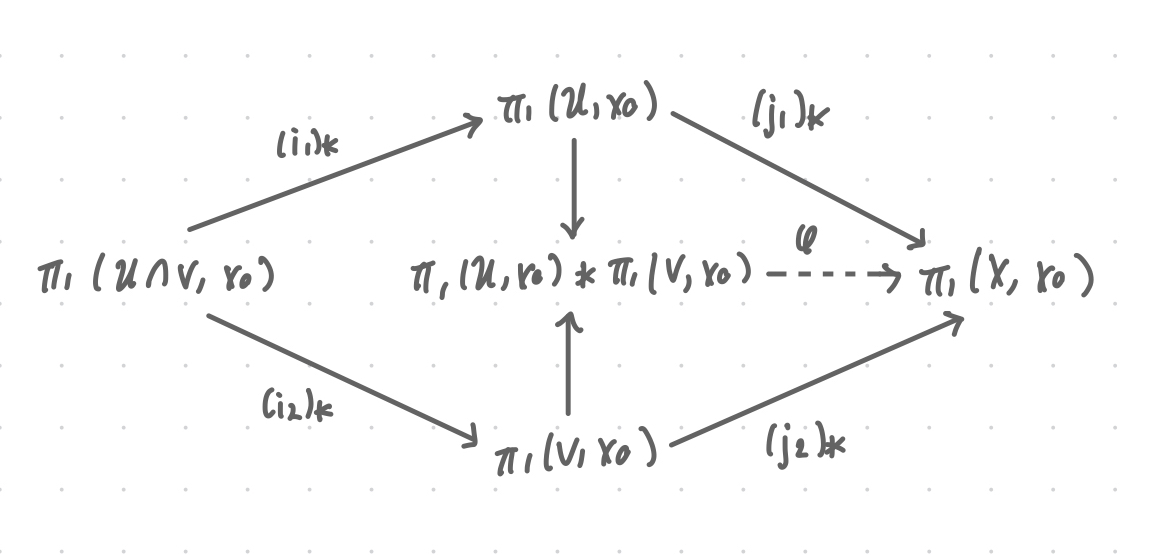Overview
The van Kampen theorem is used to compute the fundamental group of a space that is the union of some open with path-connected intersection. The first “special case” shows that given a point in the intersection , the group is generated by the images of the two groups and under the induced homomorphisms between fundamental groups induced by inclusion mappings. The van Kampen theorem states that is actually completely determined by the two latter groups, the group , and the various homomorphisms between fundamental groups induced by inclusion.
A special case
Recall the special case of the van Kampen theorem used to prove (Theorem) The fundamental group of the n-sphere is trivial in higher dimensions:
Transclude of (Theorem)-The-fundamental-group-of-the-n-sphere-is-trivial-in-higher-dimensions#^9db065
This can be rephrased in terms of free products as follows:
Lemma: Homomorphism out of the fundamental group of the free product of path-connected spaces is a surjection
Suppose , where each is open and path-connected and the intersections are also path-connected. Let be any point. For each , there exists an inclusion which induces a homomorphism between fundamental groups
Setting
the unique homomorphism out of the free product is a surjection. Equivalently, the images of all generate .
The homomorphism just concatenates loops, and the previous lemma showed that any is of the form
where .
In particular, works by applying either or to some element in the free product, depending on which fundamental group the element originally comes from.
- Corollary: if decomposition both simply connected, intersection path connected, then whole space is simply connected
Weak van Kampen
Theorem: Weak van Kampen
If , each is open and path-connected, is simply connected, and , then the homomorphism
is an isomorphism.
Stronger van Kampen
Theorem: Strong van Kampen (statement about the kernel)
Let where are open and path-connected, is path-connected, and . Then the unique homomorphism out of the free product
has kernel
where and are homomorphisms induced by inclusion mappings for the intersection.
Equivalently, the kernel is the smallest normal subgroup containing elements of the form given above. This means precisely that the kernel has all elements , plus their conjugations by elements of .
Special cases
Intersection of open subsets is simply connected
The weak van Kampen, which requires be simply connected, is then a special case of the more general van Kampen theorem where is a isomorphism since its kernel is trivial: if , then by definition , so is generated by the identity only. Since is a surjection, it follows from (Theorem) First isomorphism theorem that
One of the open subsets is simply connected
Suppose is simply connected. Then is generated by the set
as is simply the identity element, and we have precisely
Examples and computations
A general strategy for constructing open sets that satisfy the hypotheses of van Kampen is to take some sets you think they “should be,” then make them to be a little bigger to be open and cover the space . For example, when , we can take to be copies of with a small open neighborhood about the point that they meet at. Similarly, if is some surface constructed by “gluing” edges to make a polygon (e.g., the torus constructed from the square, or the genus-2 torus constructed from the octagon), one can take with some point removed and to be a neighborhood about .
Simply connected intersection: The figure 8
Given , recall that the operation denotes the two copies of that intersect at a single point. Take to be one copy of together with a neighborhood of (this looks like a circle with an arc stuck to it). We know for , since each is homotopy equivalent to ( deformation retracts onto ) and the fundamental group is invariant under homotopy equivalence. Further (this looks like a curved cross) deformation retracts onto the single point , so they have isomorphic fundamental groups
and is simply connected. Then the weak van Kampen implies , the free product of rank 2.
By induction, the fundamental group of circles meeting at a single point is isomorphic to , the free product of rank .
One simply connected subspace:
The torus , considered as a quotient of the square, can be decomposed into the following: let be the filled square with a point removed, and let be a basic open neighborhood of that point. Then we have the following:
- has a deformation retraction to the boundary of the square, which has two pairs of sides with the same orientation. This is homeomorphic to , so and is generated by .
- is simply connected, so .
- is homeomorphic to the annulus, which can be retracted to and therefore has , which is generated by a single loop about the circle.
The induced homomorphism maps ; informally, the loop is embedded as a loop around the hole in , which is homotopic to the commutator of the generators . Thus, van Kampen implies
The generators commute, so this is precisely the presentation of the abelian group .
Notes
- Alternative statement of the first lemma from Algebraic Topology
Lemma: van Kampen lite
If is an open cover such that the intersection is path-connected for all and there is some for all , then is generated by the union of the images of all homomorphisms induced by inclusion mappings .
- Circle – decompose into streographic projections

